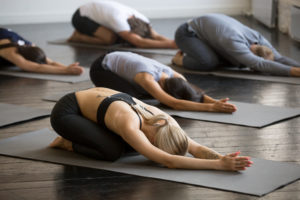Yin is a style of yoga in which students hold postures for long periods of time. It contrasts with the more fast-faced, dynamic Yang practice typically known as Vinyasa yoga, which has been popularized in the Western world.
The deeply meditative and restful practice of yin yoga is vital for creating balance in our lives. As we spend more time sitting at desks, staring at screens and driving cars, it is important to stretch and move our bodies. That said, adding a high-intensity workout or cardio vinyasa class to your routine may only work to spike your cortisol levels. A yin practice is a great way to turn on your parasympathetic nervous system, responsible for slowing your heart rate and aiding in key processes like digestion and hormone regulation.
A 2018 study found that incorporation of yin yoga for five weeks reduced both the physiological and psychological risk factors known to be associated with non-communicable diseases (NCDs), such as cardiovascular disease and cancer. “Yin yoga could be an easy and low-cost method of limiting the negative health effects associated with high stress,” read the report.
A key component of yin is targeting the deep connective tissue between the muscles and the fascia throughout the body. By doing so, you can increase circulation in the joints and improve flexibility.
Yin is accessible to everyone, almost everywhere. While props and blankets are nice to have, there is no equipment necessary for a yin practice. There are countless videos and resources online, both free and premium, that will guide you into different postures.
As self-care moves more into the mainstream, we are starting to understand why it is so important to cultivate a positive relationship with ourselves. Yin yoga gives us the space and time to connect with our breath and send gratitude to our bodies. Sitting in poses for up to ten minutes at a time, we feel what it’s like to just pause for a moment without the distractions of social media, calendar deadlines, and to-do lists.
Like other forms of meditation, it supports a practice of acceptance, one of the most helpful tools for a happy, healthy, low-stress life. Instead of running away from challenging poses or situations, yin reminds us that sitting with discomfort will help you grow. Throughout class, the mind will want you to leave the pose. Students are encouraged to listen to that voice, let it go, and observe our own thoughts and reactions from a place of non-judgment and calmness.
For anyone feeling disconnected with their bodies, yin is a perfect practice for reconnecting. Yin emphasizes listening to the body, playing close attention to the sensations in each pose and how they change throughout the class. This gives us the opportunity to be present and authentic.
When strong sensations come up, invoking memories, anxieties and tension that we store deep in our tissues, yin gives us the opportunity to let it go. While these memories and emotions can be tough to deal with at the moment, there is a long-lasting benefit.
For people who want to start meditating, but can’t seem to get themselves to sit totally still for a length of time, yin yoga may be a great introduction. In the process, you may find more ease in your body, benefiting your other workouts. Best yet, you will likely find that you are less reactive to stress, more joyful, and find it easier to connect with your heart and practice compassion for yourself and others.




